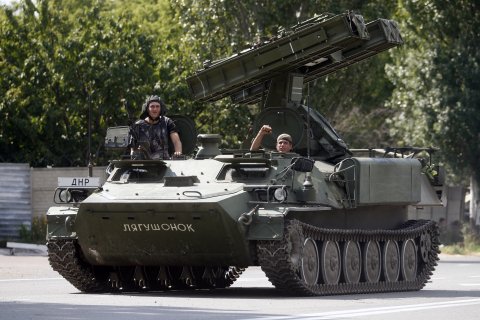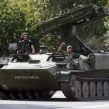
Vladimir Putin’s Dirty Little War
Publication: Eurasia Daily Monitor Volume: 12 Issue: 21
By:

Since Moscow’s intervention in Ukraine in February 2014, its ongoing operations center upon “plausible deniability.” With the passage of time and more and more evidence entering the public domain, however, “plausible deniability” has appeared increasingly ridiculous. The Russian political-military leadership continues to repudiate any involvement of the country’s Armed Forces in southeastern Ukraine, or the supply of weapons, military equipment and logistical assistance to the separatists (Gazeta, January 22).
While the North Atlantic Treaty Organization (NATO) and its governments continue to accuse Moscow of direct and indirect activities linked to its active involvement in Ukraine, senior Russian officials repeat a mantra of disavowal. These views permeate analytical articles in the Russian military media. Illustratively, a recent article in Nezavisimoye Voyennoye Obozreniye by its editor Oleg Odnokolenko presented views on the conflict predicated on such denial (Nezavisimoye Voyennoye Obozreniye, January 30).
However, observers note the presence of Russian-manufactured and defense ministry–owned weapons and equipment appearing on Ukrainian territory. One such example relates to the shelling of Mariupil using Grad and Uragan multiple rocket launcher systems (MRLS). Also, in late January 2015, footage emerged in the rebel-held town of Shakhtarsk showing two Pantsir-S1 truck-mounted anti-aircraft and surface-to-air missile (SAM) systems—a modification specifically incorporated into the Russian Armed Forces in 2012 (The Moscow Times, January 28).
Consequently, it is worth examining some examples of the presence of Russian weapons systems and military equipment in southeastern Ukraine in order to demonstrate the presence of Russian military personnel (Livejournal, January 15). These weapons systems and items of military equipment not only come from the Russian military inventory but, in some cases, are also modern and advanced—which places great demands on those using such technology, if they have insufficient training. The Ukrainian National Security and Defense Council has also alleged the presence of advanced Russian weapons systems and military hardware, including, TOS-1 Buratino MLRS, S-300V SAM systems, 9K58 Smerch and 9K57 Uragan MLRS, T-90 tanks and BTR-80AM armored personnel carriers (APC) (UNIAN, January 17). However, apart from tanks and unmanned aerial vehicles (UAV), even clearer evidence exists in relation to other Russian military hardware, ranging from electronic warfare systems, armored vehicles and even sniper and assault rifles (Defense Express, January 20).
In November 2014, the 1RL257 Krasukha electronic countermeasures (ECM) jammer was used outside the Donetsk National Technical University; this Russian system blocks military aircraft radar and UAV command channels at a range of up to 300 kilometers. Reportedly, Aistenok portable counter-mortar radars have also been identified in Donbas (eastern Ukrainian region encompassing Donetsk and Luhansk provinces). This system was shown to representatives from the Organization for Security and Cooperation in Europe (OSCE), in Donetsk in January 2015. Its manufacturer, the Tula-based Strela Production Association, says that the Aistenok detects mortar firing positions at up to 5 km and provides trajectory-based artillery fire adjustment up to 15 km (Eizvestia, November 8, 2014).
Moreover, a number of different lightly armored vehicles of Russian resonance have been identified in Donbas. These include BPM-97 KamAZ-43269 Vystrel/Dozor Infantry Fighting Vehicles (IFV). Since this platform was cleared for export in 2005, only a small number have been exported—none of which were purchased by Kyiv (Military Review, January 9). In addition, on January 10, 2015, the four-wheel-drive GAZ-3937 Vodnik was spotted in operations. Again, although this platform has been exported from Russia, none of the contracts included Ukraine. Equally, Tigr-Ms were identified in a convoy passing through Ukrainian territory on their way to Luhansk (Informator, January 15).
In December 2014, Ukrainian separatists were also reportedly using the KSVK/ASVK Kord sniper rifle, part of the 12.7-milimeter 6S8 Kord sniper system. The Kord entered use in the Russian military in mid-2013 and is used against lightly armored and non-armored vehicles at up to 1,000 meters and against enemy personnel at up to 1,500 m (Novosti News, December 1, 2014). Samples of these were seized by Ukrainian troops at Donetsk airport on January 14. Footage of Donetsk separatists in January 2015 reveals the use of the silent and flameless 9-mm AS Val assault rifle, used by Russian special forces and the Russian Interior Ministry Troops (Censor.net, January 15).
It is clear that a fairly large quantity of Russian weapons systems and military equipment has “appeared” in southeastern Ukraine. Since the Russian defense ministry and individual units tightly control these assets, it can only be deduced that such items are not only deployed with the full knowledge and backing of the political-military leadership, but the high-technology items also lend credence to reports of Russian troops on the ground in Donbas (Defense Express, January 20). Many of these systems are sophisticated and simply way beyond the capacity of the poorly trained and otherwise inadequately experienced separatists. Indeed, a significant proportion of this hardware demands specialist military training and cannot be operated properly by amateurs.
In recent years, Russia’s defense leadership has placed growing emphasis on increasing the numbers and boosting the training of contract personnel (kontraktniki). This is precisely because the posts in the table of organization and equipment (TOE) that determine combat capability and combat readiness demand specialists with professional training. While this is true generally, there are more specific examples (see EDM, March 12, 2013). Since 2011, Moscow has been introducing specialist sniper companies into the TOE. In 2012, this was stepped up, and the discussions of the top brass in the military press noted how highly specialized these roles are in combat. The snipers require specialist and tailored training (see EDM, March 20, 2012). Equally, much of the reported Russian weapons and equipment finding its way into Donbas cannot be operated by inexperienced handlers; from a Russian military perspective, such hardware would demand the presence of kontraktniki, and largely excludes conscripts.
Clearly, there are claims and counter-claims among the conflicting parties in Donbas. What does the presence of large quantities of often sophisticated Russian weapons ranging from the Pantsir-S1 to the Kord sniper system or hardware including Tigr-M or BPM97s reveal? It supports the presence of Russian kontraktniki from various branches of Russia’s Armed Forces at least in a training, guidance and mentoring role to maximize the use of the systems and equipment. Ukrainian President Petro Poroshenko claims there are around 9,000 Russian troops in eastern Ukraine, while NATO estimates are somewhat lower—no more than a brigade-strength in total. These are likely to be drawn from a variety of units. Their unofficial presence in Ukraine is partly driven and demonstrated by the Russian equipment crossing the border, but is also a wider part of President Vladimir Putin’s undeclared “dirty little war” in Donbas.




